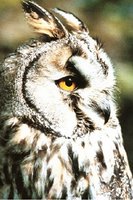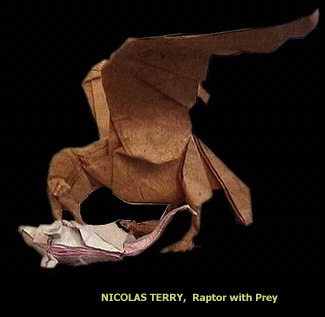
For very many bird species, you can see pretty clearly that the egg-shape of the body is important to them—is part of what the bird looks for in choosing a well-shaped mate, in the same way that an hourglass female figure seems to matter terribly to us Modern Humans. You can see this in the way the eggy line on the bird is tightly defined: it’s not just a matter of us viewers reducing what we see to groups of abstract egg-shapes (though of course we do that too).
If you ask why this is, there's a standard explanation for how well-defined forms like tails, body shapes, or striking colors develop: The females want them. Here presumably, in some species, some females had at first a slight predisposition to egg shapes (maybe this helped them care better for their brood). Males who could capitalize on this susceptibility by being a bit egg-like themselves did better with the females. The offspring of such unions then would have inherited both the eggier shape (in males) and the greater susceptibility to that shape (in females). This goes round and round, generation after generation, till you end up with a well-defined form like the one above. Or anyway that’s how the ‘Darwin-Fisher hypothesis of ‘runaway sexual selection’ --the most venerable of the theories on how fancy features evolve--would work, if applied to this case.
For a fleeting moment you might think the reason for the egg shape is ‘developmental’ or ‘functional’. That is: birds come from eggs, so maybe it is simpler to grow in a way that retains the original shape while adding the minimum number of relevant appendages. Unfortunately for this ‘functionalist’ idea, its not just birds that come from eggs--and not even just turtles and lizards and dinosaurs and such. We all do; and the egg shape is by no means as equally pronounced in us all. No, this seems to me an aesthetically-driven phenomenon: the curvature that we see is playing a role in its own selection. (I concede there is one ‘developmental’ explanation that’s remotely plausible: small birds that lay very large eggs will have their outer shape determined by what they’re carrying inside.)
Now, how would you go about proving any of this—even the observation itself, which is an Obvious Visual Fact for me but may not be so for everyone, or anyone, else? But the advantage of a blog like this, is you can raise suggestions, make observations and not worry if they’re testable, or are already established scientific facts, or will be hooted down by academics (who won’t sully their reputations by admitting to be reading this). That’s the advantage too of not being owned by a University and obligated to publish in research journals (I admit, there are disadvantages). And it’s the advantage of dabbling in origami which is inherently an outsider’s occupation, and is inherently free, and is inherently inconsequential. It doesn’t matter if you’re right or wrong (at first). You are free to conjecture—exactly as free as you are to flex the paper this way or that. Nobody is going to get hurt.
>Added October 2009:
The idea of a bird retaining in its body-shape the basic form of the egg it came from (with just a head-blob and some tail feathers glued on) I have not seen anywhere, certainly not in the respectable biological literature which would never go out on a limb with this sort of observation. Which is a shame: fearlessly noting the basic features of the natural world as one sees them is left to others, to marginal types. But here there is a wonderful poem I came across recently by the ever sure-footed Richard Wilbur, whose job it is to observe and record. He speaks similarly of “the oval form of sleep”—not in reference to the egginess of bird outlines, but of the shape of the first pseudo-leaf of the cotyledon as it emerges from the earth:
http://tisiwoota.blogsome.com/2006/01/01/seed-leaves-by-richard-wilbur/
* * *
Having talked myself into it, here is another conjecture: still in the general realm of bird-shapes, but no longer now about egg-forms.
This one is about Owls. They always have these strange, haunting faces. I suggest we pay attention to this fact, as it’s universal among all owl species. Those faces will strike fear into the likes of us, who used to be small tasty foot-high morsels until quite recently.
Now if you look more closely, a lot of owls don’t just have strangely haunting faces, but faces that look specifically un-bird-like. In fact—their faces are strangely mammalian. Go ahead, take a minute to confirm this assertion (or challenge it if you dare) by Google-imaging pictures of owls.
hm hum hoom hm hmm hm hmm
--Good, you’re back.
My favorite example of a mammal-like owl is also the most extreme case that I’ve seen. It’s the owl that’s in my zoo here in Beersheva: a Bubo bubo.

What’s extreme about this particular owl is that it isn’t just going after a mammalian look in general; you actually can name the genus it is trying to mimic: it is---the CATS.
Actually there are plenty of owls that are called ‘cat-owls’ because of their appearance —the mottled ‘fur’, the flattened oval-triangular face, the tufts at the top of the head that are mimicking ears (the owl's actual ears are lower, on the rim of the oval), the yellow eyes, the small hooked nose.

But this owl in my zoo, though in English it is called an ‘Eagle Owl’, goes a step further in the direction specifically of cat-hood: it sometimes sits on the ground rather than in a tree, and when it does, it slouches its body to one side casually in the way that’s absolutely typical of a cat but quite unusual for a bird. You don’t quite know what you’re looking at until you're looking VERY closely.
[A picture here would help, but needless to say--the owls kept to the trees and wouldn’t slouch on the ground for me when I returned to the zoo for a snapshot. And on the Web too it’s hard to find the effect I wanted… But here at least are a few pictures where you can see how these owls are turning into cats.]
http://www.jeremyp.net/scotland/Pages/Image12.html
http://www.birdwatchingtours.co.uk/gallery/pix/Morroco/Pharoah%20Eagle%20Owl_L%20copy.jpg
http://www.britishwildlifecentre.co.uk/animals/eagleowl.htm
[The last of these gives the standard, and perfectly blind, Textbook Explanation of the pseudo-ears.]
Now, there are LOTS of reasons why an animal would want look like another more dangerous animal or one that’s higher on the food chain. Most of these have to do with safety from predation, and sometimes with gaining an edge in the sexual or social arenas by appearing fierce in certain specific ways. Always in cases of such so-called mimicry, the question asked about what’s guiding the evolution of the mimicry is: Who is being fooled--and how does that help the deceiver?
I have an idea of this, for Bubo bubo and the other cat-seeming owls. (It goes well beyond convergent evolution, the adaptation of two species to similar conditions in the environment.) The idea is prompted by noticing that cats and owls have exactly one thing in common: they hunt the same prey. --Voles, field mice, small nocturnal animals, other smaller birds… I suggest that what’s driving the development of these haunting features, often ‘mammalian’ and sometimes specifically ‘catlike’—is not mainly the owl’s predators but rather it’s prey.
How might this work? Why should what prey thinks of its predator have any effect on how the latter looks? (Usually its only the consumer, and not the consumed, that has any say in matters of appearance.)
My answer is this: a prey animal on noticing a predator has two basic and very different response options: freeze or flee. It’s a crucial, life-deciding choice, it has to be made instantly, and there is no in-between: if you’re doing one thing you are manifestly not doing the other. Now, the ‘right’ response to the quick first perception depends on what kind of predator it is. Basically if it’s a bird, you’ll want to flee to any near bush cover; if a cat, to freeze (or if there's a tree nearby to run up it). The specific details always depend on the local situation, but crucial information in the decision What To Do is what type of predator it is. Remember that Vervet monkeys have even developed different calls to warn troupe-mates when it is a flying vs. a stalking predator that’s been sighted! So, sitting in the bole of a tree in the dark, an owl that can confuse the issue even slightly gains an edge at the crucial moment. And an owl that can confuse the issue a lot gains a significant edge: the perfect graded path for evolution to move on.
That’s my hypothesis, anyway. And perhaps it’s even a testable one. (You real Natural Historians out there, with tenure, time, and access to research grants, could you go out and check this one for me?)
For some reason I seem to have developed a yen tonight to go fold some owls.
